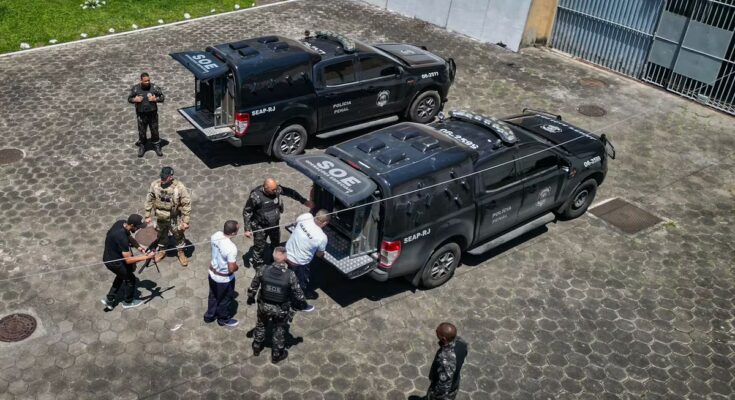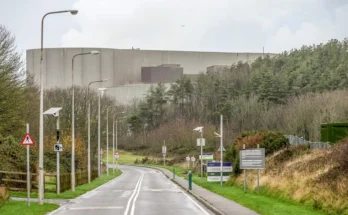Seven leaders of the Red Command, one of the most powerful Brazilian organized crime groups, were transferred this Wednesday from a state prison in Rio de Janeiro to the maximum security federal prison of Catanduvas, in the city of the same name in the state of Paraná. The transfer was carried out on a police plane and at the request of the Rio state government, as part of the strategy to weaken communications between the leadership and gang members. The seven are accused of having ordered, on the 28th, the blockade of the streets of the entire city of Rio de Janeiro to sow chaos in response to the police operation that caused 121 deaths that day, the deadliest in Brazil.
These prisoners are serving sentences for crimes such as drug trafficking, murder, organizing escapes… Seven of them have a total sentence of over 500 years.
The seven middle leaders of the CV were transferred from Rio’s Bangú prison to Rio’s international airport in a convoy under heavy police escort. Aerial images show them on the tarmac as they boarded the plane. Their hair is shaved, their hands are cuffed to their waist, they are wearing a white t-shirt and blue pants. Luiz Inácio Lula da Silva’s government criticized the Rio executive for publicizing the transfer before its completion, which the former said could have led to a rescue attempt.
They were initially taken to the Catanduva penitentiary, precisely where the considered top leader of the CV, Fernandinho Beira-Mar, has been serving his twenty-year sentence. From Catanduva, these seven inmates will be distributed to other federal prisons, located in the states of Rio Grande do Norte, Mato Grosso do Sul and Rondonia as well as Brasilia, according to G1, of the Globo group.
After the bloody police operation, Congress accelerated the debate on a bill to combat organized crime. The author of the bill is Guillerme Derrite, known as Captain Derrite, a former officer of the military police of the assault troops who headed the Secretariat of Public Security of São Paulo at the beginning of this mandate, when the mortality of the security forces of São Paulo increased significantly. Negotiations with the government to implement the law led it to refrain from declaring the Red Command, the First Capital Command and other organized crime groups as terrorist organizations, in line with US policy.
The seven transferred CV prisoners were locked up in a prison in Rio, its strongest place and the city where the group was born in the late 1970s. Twenty years ago, Brazil created a network of maximum-security federal prisons to lock up the country’s most dangerous (and powerful) prisoners, as organized crime factions dominate many of the state penitentiaries across the country. A penitentiary system specialist recently defined, ironically, Brazilian prisons as a public-private collaboration. Right up to the door, the State rules. Inside the country, management falls to armed groups.
The Red Command, which numbers around 30,000 men, has expanded across almost all of Brazil in recent years. It dominates the so-called Solimões route, which transports drugs from Colombia or Peru, along the Amazon River, to the Atlantic coast for domestic consumption or export to Europe.
The police operation which culminated at the end of September with a bloody ambush in a forest between the Rio favelas of Alemão and Penha aimed to stop the expansion of the Vermelho commando and capture its top street leader, Edgar Alves Andrade, but the officers were unable to locate him. When the operation was not yet finished, the Red Command activated its men, who immediately closed streets and avenues throughout the city with buses and cars which they placed as barricades and set them on fire. They left only the southern area quiet, the one favored by tourists, where the beaches of Copacabana and Ipanema are located. They sowed chaos throughout the city, on the orders of the people now relocated, according to the authorities, so much so that hundreds of thousands of people had serious difficulty returning to their homes.
According to authorities, at least 80 of the people killed in the police operation had serious criminal records. Four others were police officers. The Rio Public Prosecutor delivered his report on the autopsies. He points out that two of the bodies had atypical wounds: one, a gunshot at close range; the other, beheaded, reports O globe. It is also specified that all the bodies were of men with gunshot wounds to the chest, abdomen and back. Many of the deceased, according to the Public Prosecutor, were wearing camouflage clothing, bulletproof vests, boots and gloves.
On the other hand, the Civil Police revealed that only 57 of the 128 officers of its elite force employed in the operation had cameras on their operational uniform. The bodywork has alleged technical problems.



